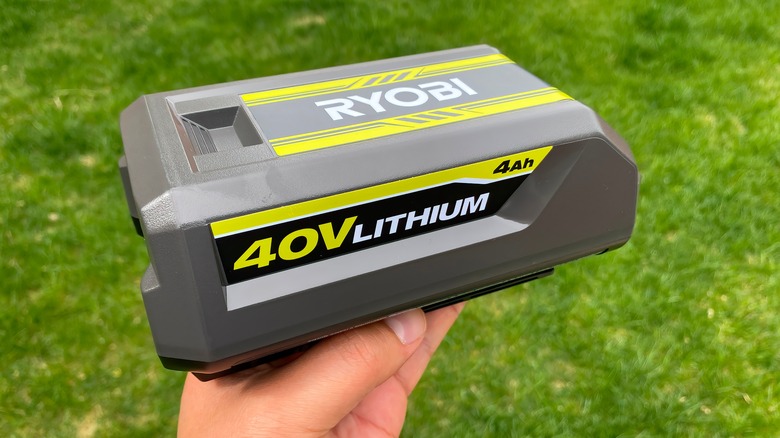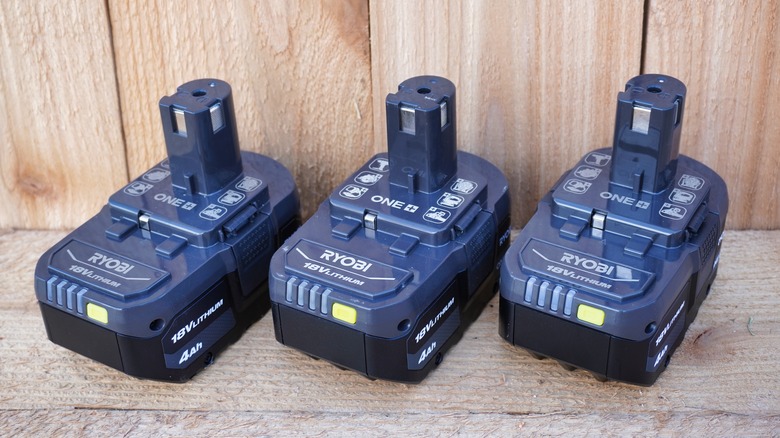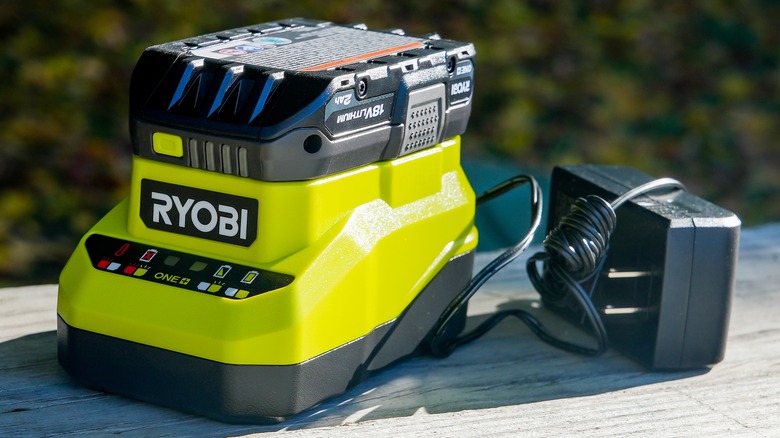Ensure The Longevity Of Your Ryobi Tool Batteries With These Simple Tips
One of the biggest advantages of using a good power tool brand like Ryobi for your home is the ability to work from anywhere. Since Ryobi tools have rechargeable batteries, there's no power cord. Plus, these tools have a quieter operation. Cordless Ryobi power tools can help with remodeling a basement, hanging a picture on the wall, and dozens of jobs in between. However, they can only deliver their benefits if the battery is working properly.
Whether you have one or several Ryobi rechargeable batteries in your collection, you can take a number of steps to make sure they're in prime working condition. We'll explore a wide range of tips you can use to preserve the battery life and capacity, but perhaps the easiest thing you can do immediately is to store the battery in a climate-controlled area around 60 degrees Fahrenheit. If stored in areas with too much heat, the excess temperature affects the lifespan of the lithium-ion battery, perhaps reducing it by half versus storing it in a climate-controlled location.
If you are looking for new Ryobi batteries and power tools, remember that you cannot do price comparisons between Home Depot and Lowe's for better deals. Ryobi is only available at Home Depot.
Tips for storing your Ryobi battery properly to preserve longevity
If you're like most DIY-ers who use Ryobi cordless power tools, the battery spends more time not being used than in use, as your DIY jobs don't occur on a daily basis. Consequently, it's important to store the Ryobi rechargeable battery properly between jobs to ensure its best possible lifespan.
Never place the battery in storage after you completely discharge it. Instead, you should place it on the charger and let it reach at least 50% capacity. Reaching 100% capacity is fine, too. Once it reaches the desired level of charge, remove it and place it in your storage area. Although some people leave it on the charger long term, the best way to avoid overcharging, which could reduce longevity, is to remove it from the charger for storage.
When storing your Ryobi batteries, avoid placing them in areas where they could suffer damage. Keep them away from areas where something heavy may fall on them, puncturing the battery case or crushing it. Once the exterior suffers damage, the toxic materials inside could leak out, ruining the battery and potentially damaging other items nearby. It's also important to take time to clean any dirt or grime from the silver contacts on the Ryobi battery where it slides into the charger. A dry cloth should be successful in removing the grime before it goes into storage, avoiding any long-term damage to the contacts.
How to charge your Ryobi power tool batteries to ensure longevity
Extreme temperatures cause problems for rechargeable Ryobi batteries. Try to avoid charging it in atypical low or high temperatures. Using the charger in a climate-controlled area works best for maintaining longevity of the battery. After charging it, it may have some excess heat from the process. Repeatedly using a heated-up battery could shorten its lifespan. It's usually best to let it cool for a few minutes before putting it on a tool and using it for a DIY job.
As you use the Ryobi power tool continuously for a tough job, the battery is going to heat up quite a bit. If it runs out of power while in this heated state, placing it immediately on the charger could shorten its lifespan. You should let it cool for 30 minutes before attempting to charge it again.
You may have heard that you should immediately remove your Ryobi batteries from the charger after reaching 100% capacity to ensure longevity. At one time, this was true. Ryobi used Ni-Cad battery chemistry several years ago, and this chemistry's longevity suffered when people left the unit on the charger too long. With modern lithium-ion chemistry, though, this risk is significantly less. Removing it for long-term storage is still the better option, but it's not as important as it was with older battery chemistry and technology.


